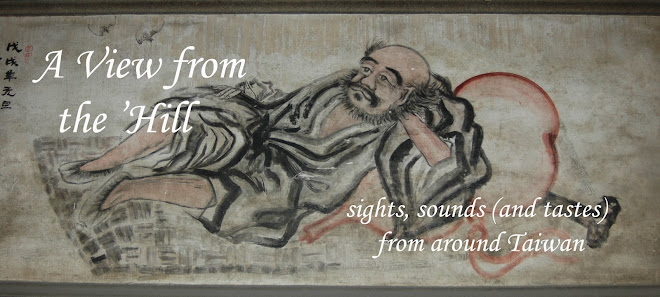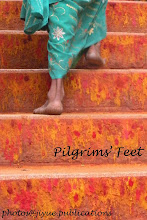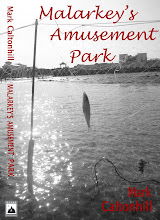– Joining Taiwan’s Saisiyat ethnic minority for a three-day religious festival
my second piece for GT (http://life.globaltimes.cn/life/2011-01/612864.html), though it used a different headline and, indeed a different photo of a different ethnicity dancing in a different location at a different time of the day

According to the legend of the Saisiyat people living in the mountains of Taiwan's Hsinchu and Miaoli counties, their ancestors accidentally exterminated a tribe of dwarf people from whom they had learned hunting, farming, brewing and other skills. To atone for this deed, at the full moon in the tenth lunar month every second year, they invite the spirits of this lost tribe to a three-day festival of singing, dancing, traditional foods and drinking their home-brewed millet wine. The Global Times recently went to find out more.
The 14 extant ethnic groups of Taiwan Aborigines comprise less than 2 percent of the island's total population, yet over four centuries' migration of Han-Chinese and the resulting social and political dominance, each has managed to preserve its identity, language and traditions.
One such tradition is the Pasta'ai (Dwarf Spirit Festival) of the approximately 5,000 Saisiyat people. It is held biennially in their home villages in the Nanzhuang Township of Miaoli County and Wufeng Township of Hsinchu County in the Xueshan Mountain Range of northwest Taiwan.
For decades it was a little-known, almost secretive event, but recently it has opened up to the outside world. And although at times this might look like just a booze-up, visitors are reminded that it is a religious rite and are asked to be respectful and well behaved. Immediately after having arrived, for example, locals and outsiders alike must call at a makeshift altar. Here, for a small cash donation, a sacred silver leaf is tied around their forehead or upper arm (and another around any camera or recording equipment).
Visitors may then enter the festival ground, but, for now, only Saisiyat tribe members may join in the dancing. Wearing self-made hand-stitched vests and other garments in the tribe's distinctive red-and-white colors, dancers link arms in long lines and perform a swaying backward-and-forward movement. This is designed to accentuate the movement of the rear, thereby creating a percussive rhythm on the "buttock bells" hung on the small of their backs. All the time the performers sing of their sorrow and gratitude to the spirits, and appeal for forgiveness.
Wiping out the dwarf people – said to measure just three feet tall – was not intentional, they chant. According to oral tradition, passed down from generation to generation in this three-day event, the tragedy occurred after just such a party as this.
Originally invited in gratitude for teaching the Saisiyat to hunt and farm, the Ta'ai, as the dwarves were known, had to cross a rushing river to attend their neighbors' annual harvest festival. Renowned for their singing and dancing as well as their warfare and magic arts, the Ta'ai were also infamous for their womanizing. Pregnancies often followed their visit, but the Saisiyat were too afraid to do anything about it.
Except on one occasion, when a young Saisiyat warrior, seeking revenge for the sullied reputation of his sister, sawed a notch from the log bridge used by the Ta'ai when returning home. His plan was too successful, and all but an elderly couple of dwarves were killed; the Saisiyat have been singing and dancing in atonement since.

For the first few hours each evening as the local Aborigines dance, outsiders watch, listen, take photos, purchase snacks and, above all, toast – and are toasted – with xiao-mi jiu (millet wine).
This fermented millet drink is of low strength (usually around 4 percent to 5 percent alcohol) but may be pepped up with grain alcohol. It is produced by the locals and bears no government-approved label denoting ingredients and strength, so visitors are advised to be cautious. Purchasing a bottle or two is recommended, however, as the hospitable Saisiyat constantly share from their own, and not to return the favor would be seen as rude. Many of the stalls selling the home brew provide free samples, so it is possible to choose a pleasantly fragrant version that is hopefully not too strong.
Foods are sold at the same stalls that surround the dance field, and at impromptu restaurants erected in one or two side alleys. Slate-roasted "boar" – likely just pork but possibly locally reared – and more exotic meats such pigeon or other small birds, plus a range of unusual high-altitude vegetables not found in city markets, attract particular attention. Sampling mountain fare has become popular with Taiwan's largely urban population over the last decade or two.
Indeed, the interest of the majority Han Chinese community in all things Aboriginal has mushroomed since the end of martial law in 1987 ushered in a new era of pluralist culture.
Moreover, when the island moved to a five-day working week in the late 1990s, citizens suddenly had the opportunity on long weekends to explore places and cultures they had hitherto only seen in television documentaries and travel programs.
Perhaps the opening up of the Pasta'ai to non-Saisiyat visitors should be seen in this context. And for those with sufficient time, participation in the event can be combined with walking in the nearby hills, visiting the Buddhist cave temples on neighboring Shitoushan (Lion's Head Mountain), or browsing the historic Hakka community of Beipu.
Staying in a local minsu (homestay) is a good way to learn more about the traditional community and Taiwan's Aboriginal culture. In particular, one can learn about the original anito spirit worship of the Saisiyat people, and how they view these traditions today after conversion, like most of Taiwan's Aborigines, to Christianity by Western missionaries.
Many younger revelers bring tents, however, or simply crash out on spare ground within walking distance of the festival site. This is mainly because the hours of dancing and drinking (alcohol is served by cup and ladle to the performers so they don't even need to break step) have taken their toll. At daylight, those still on their feet may stop dancing and find a place to sleep. But only until night falls again, when the Ta'ai spirits reappear and must, once again, be appeased – with more wine, dance and song.




No comments:
Post a Comment